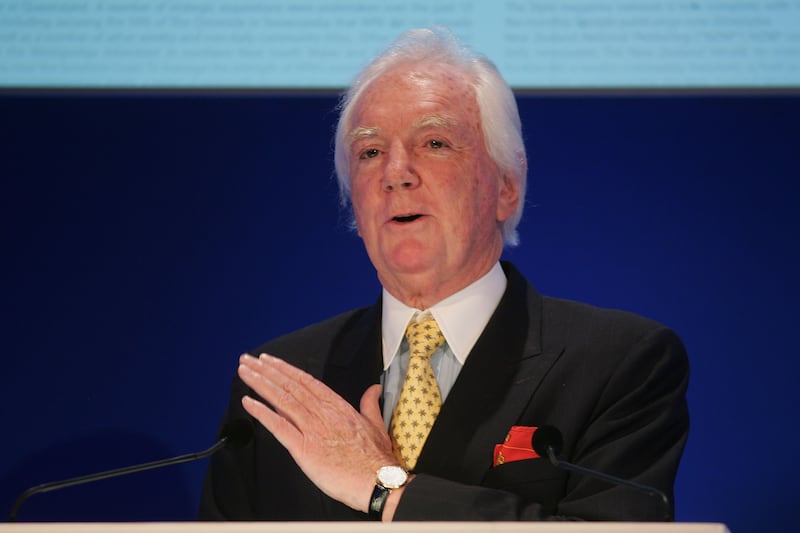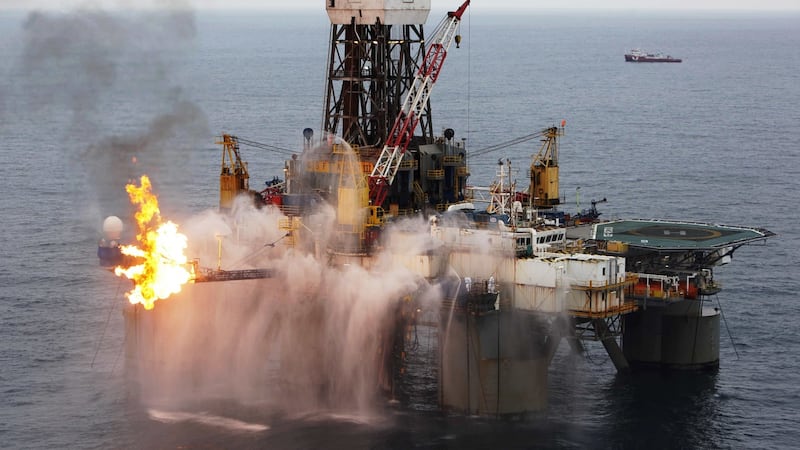Once upon a time (in 1997 I think), I purchased c£1,000 worth of shares in what was then Arcon plc, quoted on the Irish Stock Exchange.
I haven’t seen anything on this company for years and what research I have done has not given me any answer as to what I now own, what if any value it has, and how I regularise my investment.
Mr N.L.
Oh boy, you’ve been tuned out for quite a while – at least 18 years. And in doing so, you have missed one of the great rollercoaster rides on the notoriously volatile market in listed Irish exploration businesses.
On the Money: the personal finance newsletter from The Irish Times
One lender increases mortgage rates and another cuts - what is the outlook now for borrowers?
How to sort out your finances after shelling out for Christmas
Holiday problems for almost one in five Irish overseas travellers, research finds
Arcon was synonymous with Sir Anthony O’Reilly although its prime asset, the Galmoy lead and zinc mine, was originally the brainchild of serial Irish mining entrepreneur Prof Richard Conroy.
O’Reilly merged his unsuccessful oil exploration group Atlantic Resources with Conroy Petroleum in 1992 to form Arcon, in which he became very much the dominant shareholder. Fast forward to 1997, you bought your shares in the business just as mining commenced at Galmoy in Kilkenny.
At the time, O’Reilly’s name carried a lot of weight in Irish investment circles as one of the highest profile figures in Irish business thanks to his reputation as the marketing genius behind the Kerrygold brand, with his long career with Heinz. And, alongside a portfolio of other investments, he was a major shareholder and influence in both Waterford Wedgwood and Independent News & Media back before both of those went sour on him.
Although the company was listed on the Irish exchange, O’Reilly held close to two-thirds of the business by the time it was sold on to Swedish group Lundin Mining in 2005 for $123 million. That amounts to about €111.5 million at today’s exchange rates but for shareholders at the time, the value of the deal was closer to €94 million or 52.2 cent per share.

It left Arcon shareholders with a cash payment and shares in the enlarged business. About $63 million in cash was distributed to shareholders or, for those like you who did not apply for their entitlement, held for them. Arcon’s shareholders also got 5.6 million Lundin shares between them, amounting to 14 per cent of the enlarged business.
On an individual basis that meant you would have been in line for a payment of $36.2198 in cash for every 100 shares you held in the business and 3.2196 shares in Lundin.
Under its terms, each holder of 100 Arcon shares got $36.2198 in cash and 3.2196 Lundin Mining Swedish shares which, at the time, were trading at around 71 Swedish krona. To look at it another way, you got one Lundin share and $11.59 in cash for every 32 shares you held in the Irish-listed business.
Where your Arcon shareholding would entitle you to a fraction of a Lundin share – for instance, 3.2 Lundin shares – the fractions were combined and sold into the market with Arcon shareholders getting whatever cash proceeds that exercise delivered.
Shareholders with fewer than 1,000 shares in Arcon could opt for payment entirely in cash and those with more than 1,000 shares could get payment for their first 1,000 shares in cash.
You do not say what price you bought into Arcon at but the shares seem to have been trading in the mid-30 pence in 1997. Assuming a price of about 35 pence (45 cent), you will have owned more than 2,850 shares in the business and the Lundin offer would have represented a gain of about seven cent a share for you.
You were very much in the minority in not engaging with the takeover at the time as, by mid-April of 2005, close to 92 per cent of shareholders had indicated they would accept the offer. That allowed Lundin to compulsorily acquire the rest – including your stake. Arcon’s Dublin listing was given up in May of that year.
At the time you could have opted for cash for at least 1,000 of those shares and part-cash for the rest. Whether that option is open to you after all this time, I have no idea. But, given the share price performance and forex movements over the intervening time, you would be better availing of the stock option for as much of your holding as you can.
Shareholding
Assuming the figures I have used for your shareholding are broadly correct, you appear to be entitled to 90+ shares in Lundin Mining back in 2005 and cash of a little over $1,000.
You would need to contact the group’s share registrar. At the time of the Arcon takeover, that was Capita but I gather that it is now one of its main rivals, Computershare. The company’s main listing is in Toronto though it also trades on the Stockholm exchange and the email provided for investors on the Lundin Mining website is: service@computershare.com.
You’ll need to give details of your holding and, assuming you have it, your unique shareholder reference number in Arcon. They’re going to love hearing from you after all this time.
Not unusually, there has been some share consolidation and split activity over the intervening years. Some of that predates the Arcon deal but there was a three for one share split in February 2007 which means you should likely now hold about 270 shares in the business. Since the Arcon deal, the shares have traded as high as C$14.33 but as of the end of last week, these were trading at 11.75 Canadian dollars – pretty much at the upper end of their 52-week trading range – making a 270-share holding worth C$3,172.50 (€2,174).
So you are ahead on the investment though, given stock market performance over the intervening period, you might have had better options.
Of course, there is also the issue of dividends that you will need to pursue with Computershare. Lundin has certainly been paying dividends since 2017 though I am not sure what the story is before that. In those more recent years, the dividend has gone from 12 Canadian cents per share in 2017 to 16 cents in 2020, 30 in 2021 and 36 Canadian cents since.
On the basis of my rough estimate of your holding, that amounts to just shy of another C$470 in dividends over the past six years, assuming the current pattern plays out for the rest of this year.
Lundin has toyed with a couple of mega mergers since the Arcon deal and fought off one unwelcome approach but, fortunately in unravelling an already complex history, nothing came of any of them.
Providence
But there’s more. Depending on when you bought your Arcon shares, you might also have an interest in a separate high-profile name in the Irish exploration sector – again associated with the O’Reilly name.
Back around September 1997, Arcon spun off its oil interests into a new listed business called Providence Resources, led by Tony O’Reilly jnr, and featuring a stake of almost 43 per cent held by his father. Existing shareholders in Arcon were given one share in the new business for every share they held in Arcon at the time.

Providence has been focused on exploration off the Irish and UK coasts and, for investors, has been an exercise in frustration, great expectations and devastating disappointments over its 25-year life.
Successive drilling yielded only disappointment until the discovery of Ireland’s first commercial oilfield at Barryroe, off the Cork coast, in 2012.
That led to grandiose talk of Providence choosing from suitors among the oil majors to develop the field. However, more than a decade on, not a drop of oil has come ashore and the company is stuck on a battle of wills with a Green energy Minister and the Government, with the business now threatening an orderly winding down.
For shareholders who may have been on board back at the outset – including possibly yourself – any interest they had in the business has been whittled away by successive fundraising and placings that have seen the company burn through €270 million in the past 12 years.
Most recently, in a last gasp attempt to persuade the Government it had the financial heft necessary to develop the field, Providence – now renamed Barryroe Offshore Energy in a twist that shows how the company’s entire business hinges on this one prospect – the company turned to businessman Larry Goodman.
The funds he committed to underpin the cost of drilling an appraisal well at Barryroe could have given him control of the business with a shareholding of up to 75 per cent but it failed to move the Government which, after a very long delay, has declined to issue the necessary licences.
An extraordinary general meeting of shareholders last week to vote on whether to put the business into liquidation was adjourned after Mr Goodman announced a plan to petition for the appointment of an examiner to the company at a hearing that takes place on Monday.
So, having missed almost two decades of drama connected with your investment, it is still not too late to tune in to the ongoing story, even if any future for Barryroe/Providence is likely to deliver no return for you.
At least, Lundin is still delivering, although mining at Galmoy ceased in 2014 with the company blaming dwindling zinc resources at the site and a drop in the price for metal worldwide.
Ironically, although it will mean nothing for your Lundin Mining investment, a company called Shanoon Resources earlier this year secured planning permission to reopen the Galmoy mine where your investment story began all those years ago.
Please send your queries to Dominic Coyle, Q&A, The Irish Times, 24-28 Tara Street Dublin 2, or by email to dominic.coyle@irishtimes.com. This column is a reader service and is not intended to replace professional advice















